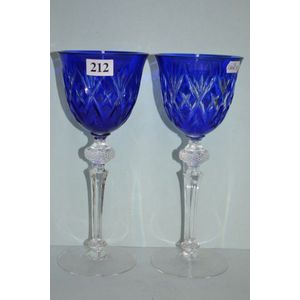Engraved Victorian Sterling Silver Chalice (1863)
A Victorian sterling silver engraved chalice, London 1863. Height 17.8 cm. Weight 262grams
You must be a subscriber, and be logged in to view price and dealer details.
Subscribe Now to view actual auction price for this item
When you subscribe, you have the option of setting the currency in which to display prices to $Au, $US, $NZ or Stg.
This item has been sold, and the description, image and price are for reference purposes only.
- Engraving - The method of decorating or creating inscriptions on silver and other metal objects by marking the surface with a sharp instrument such as a diamond point or rotating cutting wheel.
- Chalice - A chalice is a large cup or goblet that is used in religious ceremonies, particularly in Christian liturgical traditions. It is typically made of precious metal such as gold or silver, and is used to hold wine during the Eucharist, which is the central sacrament of the Christian Church. The chalice is also called the "cup of salvation" and is a symbol of Jesus' sacrifice on the cross.
In the Christian tradition, the chalice is a symbol of the blood of Jesus Christ, which is offered to the faithful as a means of grace and salvation. The chalice is used to hold the wine that is consecrated during the Eucharist and is considered to be a sacred object.
In the liturgical celebration of the Eucharist, it's passed around to the faithful, and the believer drinks from it to partake in the sacrament. Chalices are also used in other liturgical celebrations such as baptism, confirmation and anointing of the sick.
Chalices come in different shapes and sizes, from simple cups to highly ornate and decorative vessels, some of them are adorned with precious stones and intricate engravings. Chalices can also be used for other purposes, such as for holding holy water for baptism, or for the distribution of ashes on Ash Wednesday. - Sterling Silver - Sterling silver is a mixture of 92.5% pure silver and 7.5% of another metal, usually copper. Fine silver is 99.9% pure silver, and is relatively soft and the addition of the very small amount of copper gives the metal enough strength and hardness to be worked into jewellery, decorative and household objects.
- Victorian Period - The Victorian period of furniture and decorative arts design covers the reign of Queen Victoria from 1837 to 1901. There was not one dominant style of furniture in the Victorian period. Designers used and modified many historical styles such as Gothic, Tudor, Elizabethan, English Rococo, Neoclassical and others, although use of some styles, such as English Rococo and Gothic tended to dominate the furniture manufacture of the period.
The Victorian period was preceded by the Regency and William IV periods, and followed by the Edwardian period, named for Edward VII (1841 ? 1910) who was King of the United Kingdom and the British Dominions and Emperor of India for the brief period from 1901 until his death in 1910.
This item has been included into following indexes:
Visually similar items

Antique Eastern silver goblet, with engraved decoration, 13.5 cm high, 161 grams
Sold by
in
for
You can display prices in $Au, $US, $NZ or Stg.

Silver presentation cup, Burra Show 1882- Birmingham 1877
Sold by
in
for
You can display prices in $Au, $US, $NZ or Stg.

A pair of silver cups, each embossed and chased with scrolls and with vacant cartouche
Sold by
in
for
You can display prices in $Au, $US, $NZ or Stg.

Pair of WMF bristol blue cut crystal stem wine glasses
Sold by
in
for
You can display prices in $Au, $US, $NZ or Stg.
